Every year, McGill is required to submit an audit to the Quebec government detailing the university’s spending, the salaries of upper administration, and performance reports, among other things. From this audit, journalists were able to find out about Principal and Vice-Chancellor Suzanne Fortier’s $800,000+ salary for the 2020-2021 academic year, a fact that received considerable media attention and scrutiny once it was publicized. As McGill has recently submitted its audit for 2021–2022, the Daily decided to look into how much our administration is being paid and how this has changed from the previous year.
The Quebec government mandates that individual salaries be displayed for members of senior administration, which consists of Principals and Vice-Chancellors, vice-presidents, deans, the secretary general, and anyone else of equivalent rank. In the document, which can be found on the National Assembly website, compensation for each member of McGill’s upper administration is divided into their base salary and additional taxable income they received. For example, in 2020–2021, Suzanne Fortier received a base salary of $478,901 with additional taxable income of $382,070, earning $860,971 in total.
In 2021–2022, the total reported salaries of McGill administration members ranged from $147,603 to $595,325, with the average being $298,387 (Graph 1). The lowest-paid person was Robin Beech, Dean of Student Services, while the highest paid was Fortier. Fortier and David Eidelman, Vice-Principal and Dean of the Faculty of Health and Medical Sciences, were the only individuals whose total salaries decreased between 2020–2021 and 2021–2022. However, both saw an increase in their base salary, with Eidelman receiving the highest base salary of $533,624. Fortier, on the other hand, went from $478,901 to $492,543, a 2.8 per cent increase (Graph 2).
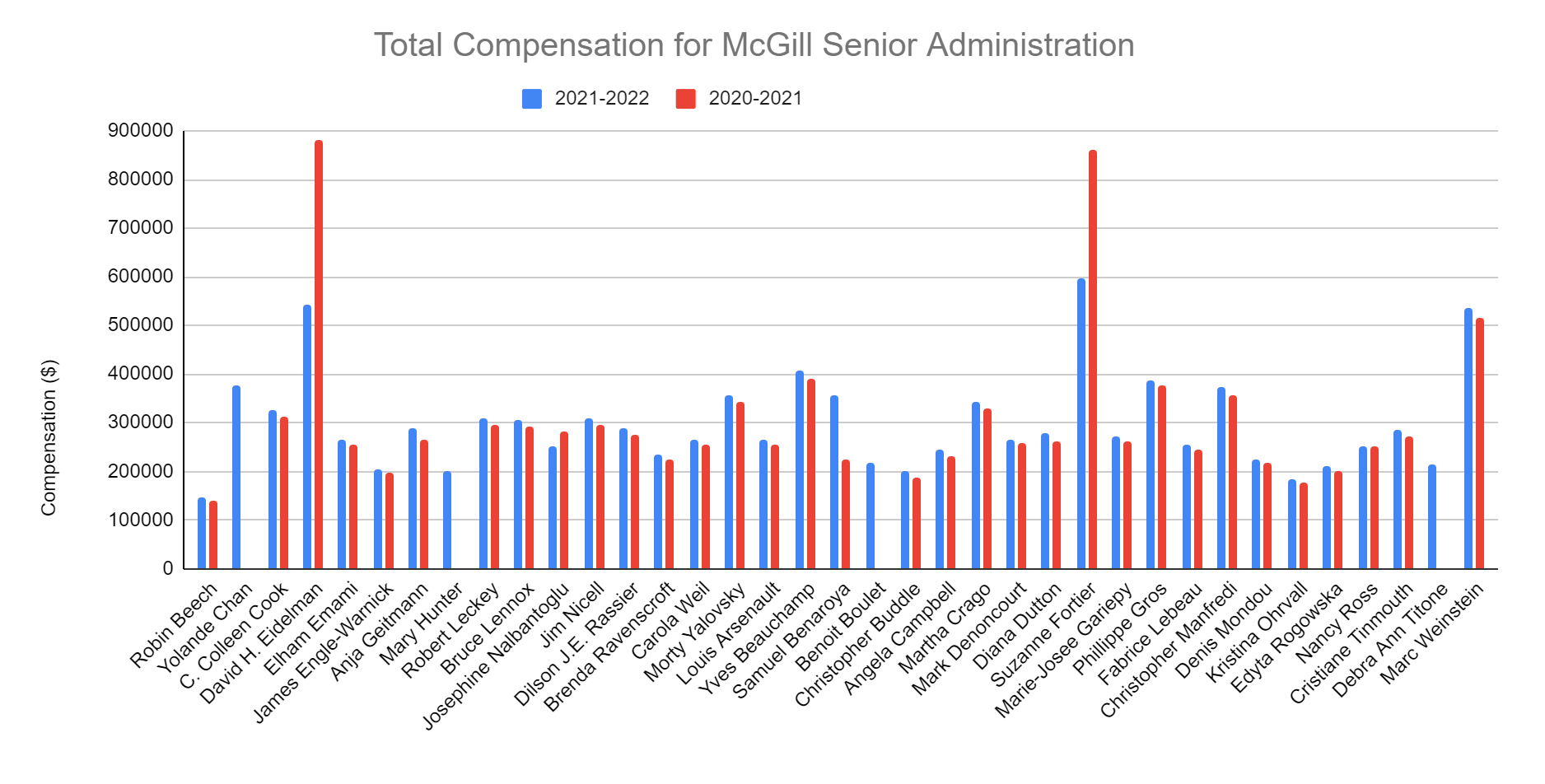
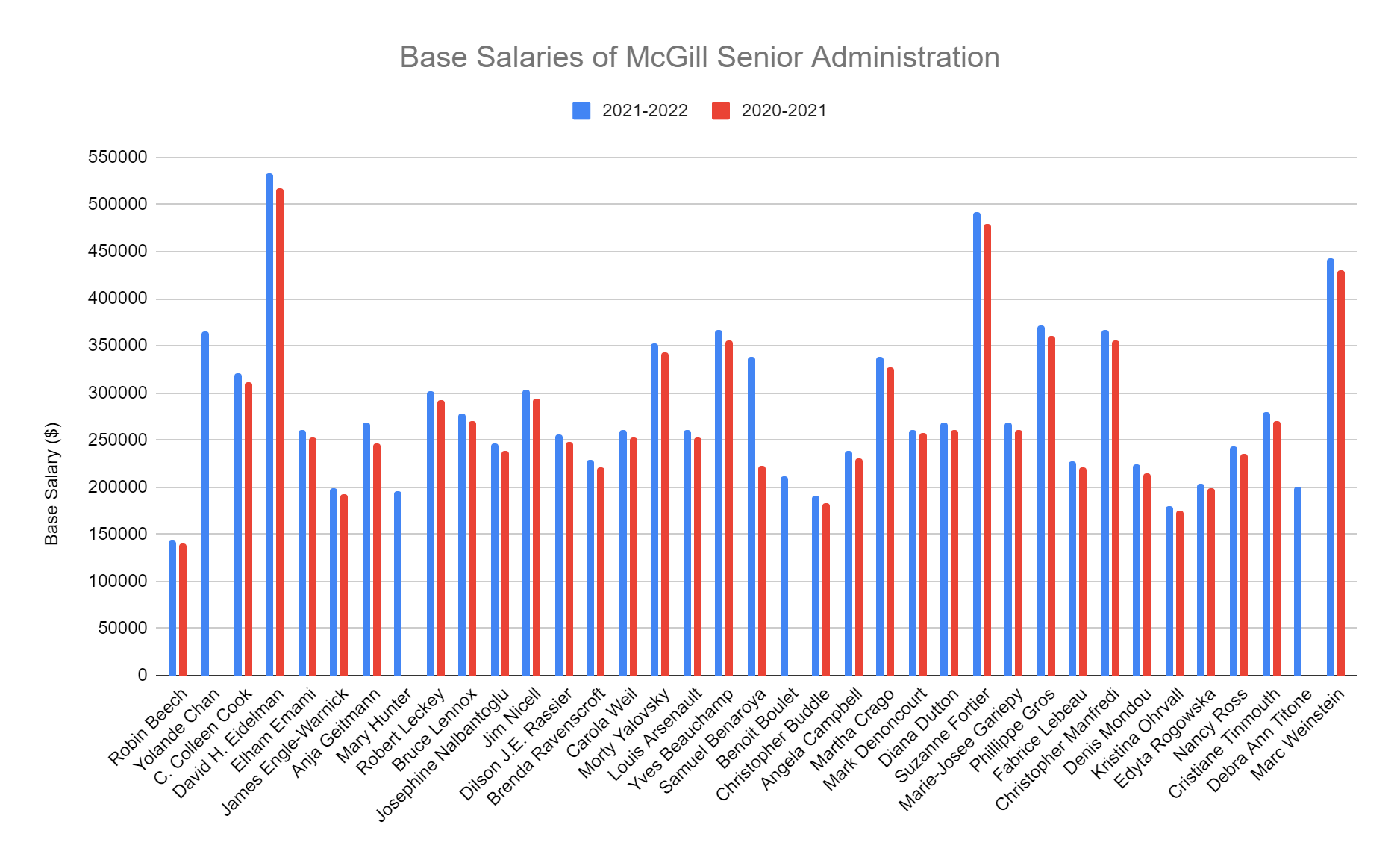
“This year, in addition to base salary, other salary components for [Fortier] and [Eidelman] included the payment of their vested portions of the supplemental pension plan for certain senior University staff in consideration of years of service since the beginning of their respective terms,” said Frédérique Mazerolle, McGill’s Media Relations Officer, in a statement to the Daily.
“It’s important to understand that the Principal’s compensation plan is comparable to those of the heads of other U15 universities across Canada,” Mazerolle continued. In comparison to her $595,325, Fortier’s Concordian counterpart Graham Carr made $466,882 in total. Fortier’s successor, Deep Saini, made $558,154 in 2021-2022 as President of Dalhousie University.
While the total compensation received by most members of senior administration seems to have increased from 2020–2021, we did not find a statistically significant difference between overall total compensation in 2021–2022 versus 2020–2021. However, when looking at base salaries, we found that there was a statistically significant increase from 2020–2021. The average base salary was $283,522 in 2021–2022 compared with $276,102 in 2020–2021.
“Salaries are determined on the basis of the qualifications of the incumbent and the relevant market data for the position,” explained Mazerolle.
The individual who received the highest pay increase in both total compensation and base salary was Dr. Samuel Benaroya, Associate Vice-Principal and Vice-Dean of Health Affairs. Benaroya’s total compensation increased from $223,233 to $356,196 (60 per cent increase), while his base salary increased from $223,141 to $338,775 (52 per cent increase).
Deans
Looking specifically at the Deans, it’s clear that Eidelman received the highest salary of all of them in every category (Graph 3). After Eidelman, Yolande Chan and Morty Yalovsky from the Faculty of Management received the greatest compensation. Aside from Beech, Arts Interim Deans Mary Hunter and James Engle-Warnick received the lowest salaries.
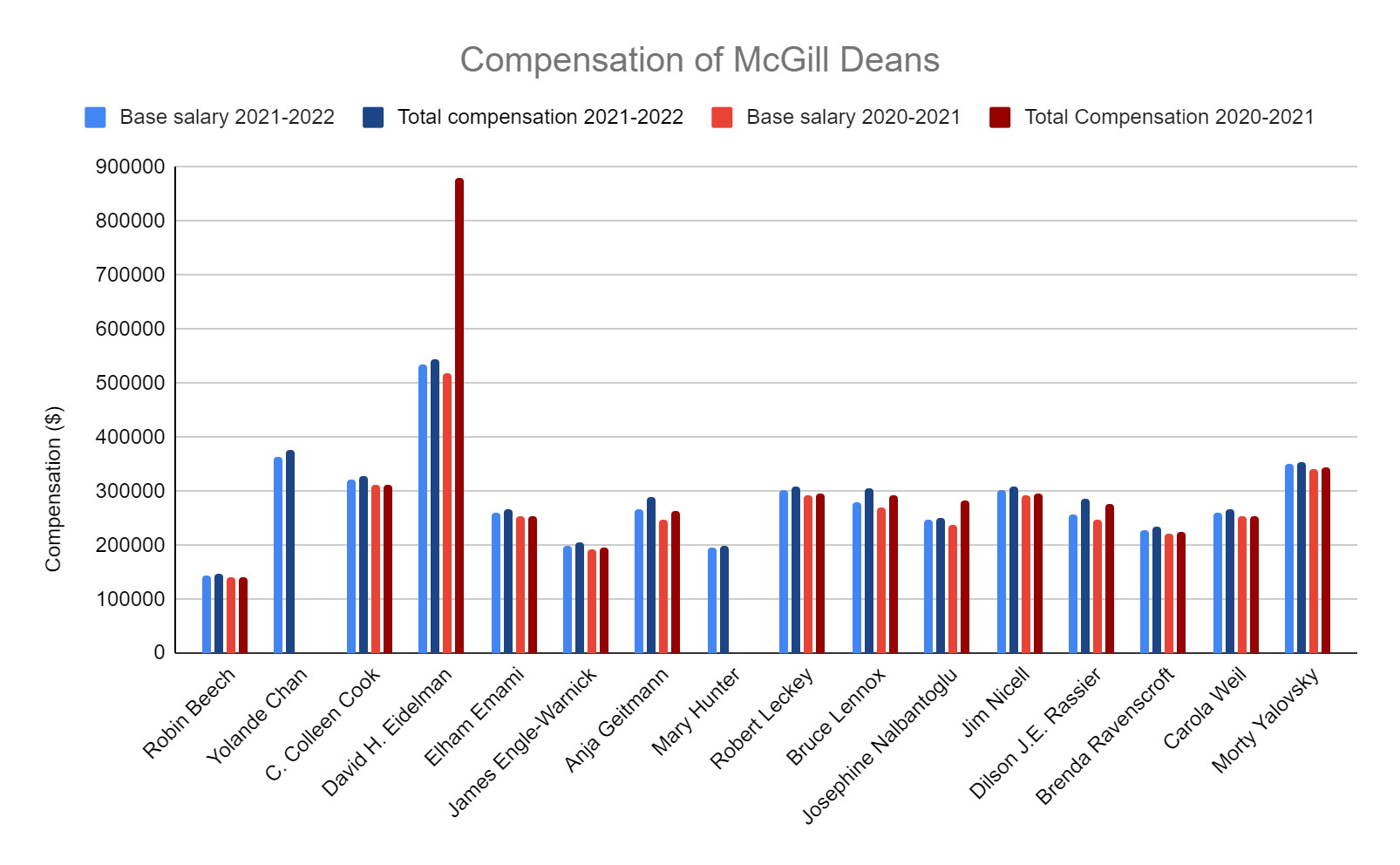
How does that compare to professors?
The Daily used data from January 2022 prepared by Analysis, Planning, and Budget to look at the median salaries of full-time McGill faculty in order to put the salaries of senior administration into perspective. At McGill, faculty can be divided into tenured or tenure-track professors and contract academic staff (CAS). Out of all the positions, full professors with tenure or a tenure-track position had the highest median salary at $180,161. The lowest-paid position was that of faculty lecturer, a CAS position that focuses mainly on teaching, with a median salary of $86,582.
When comparing the salaries of tenured professors within each faculty, there was little variation in the median salaries of each position (full professor, associate professor, assistant professor) except for those of professors in the Desautels Faculty of Management, who earned more than their counterparts in other faculties. As shown in Graph 4, the median salaries for Desautels faculty members are large outliers compared with the median salaries for the same positions in other faculties. We were unable to do a similar comparison for non-tenured faculty as data on their salaries was often not provided for privacy reasons due to a low number of CAS positions in each individual faculty.
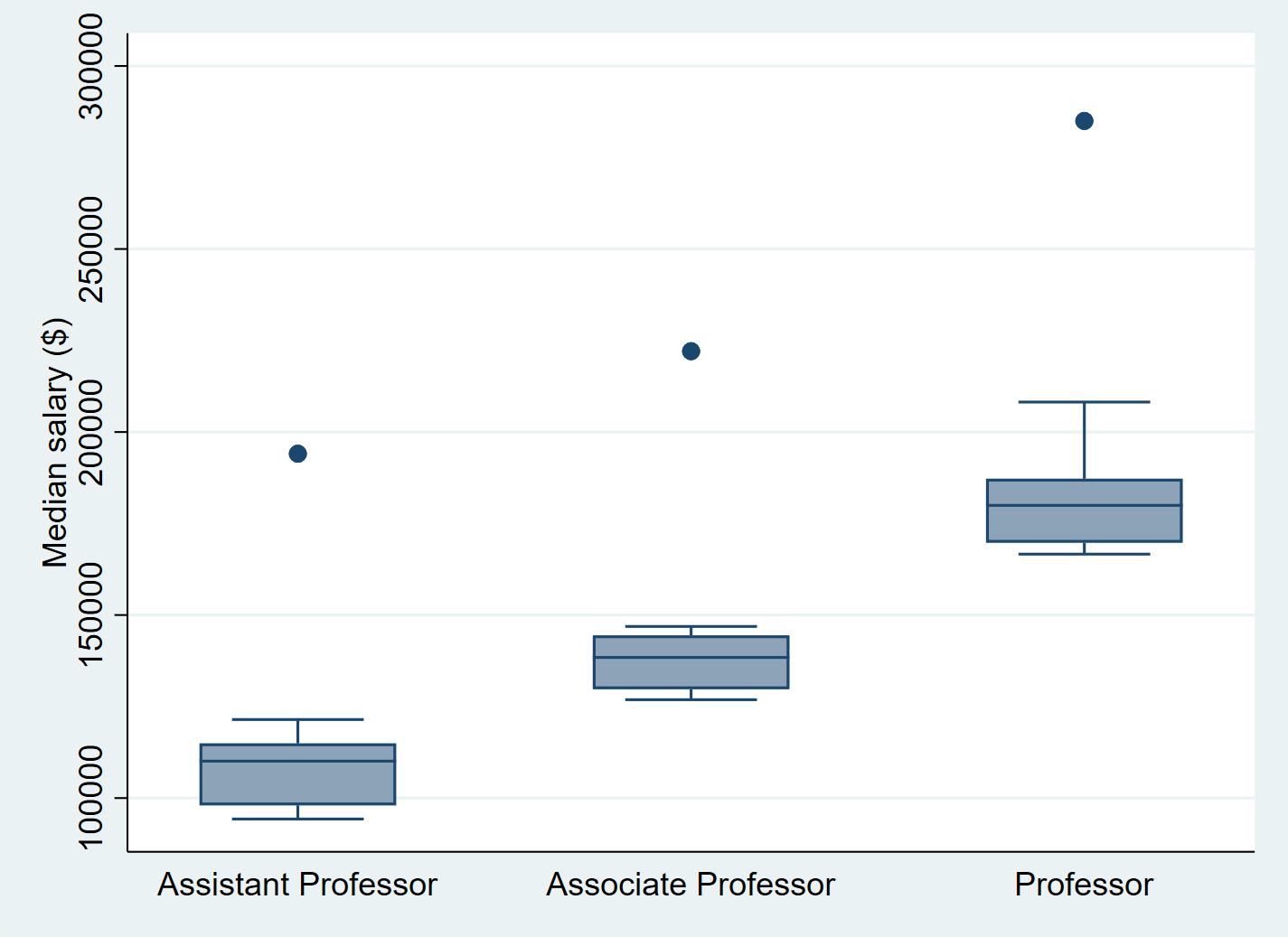
When comparing the median salary of full professors to their respective deans (Graph 5), we found that in most cases, when the dean of a faculty had a higher salary in relation to their counterparts, the professors of that faculty did as well. One notable exception was the Faculty of Medicine and Health Sciences, where Dean Eidelman received a base salary of $533,624 while the median salary for professors in that faculty was $185,386.
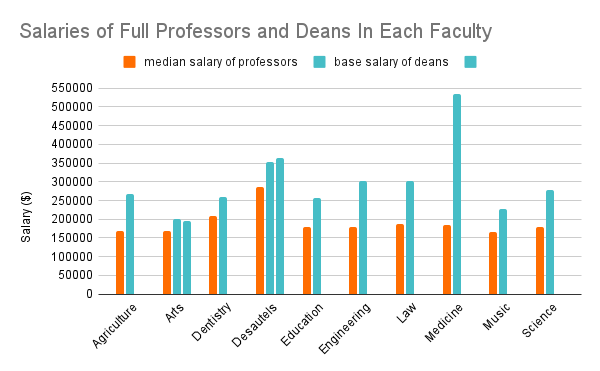
Other management staff
In addition to the senior administration, the university also has to report data on the salaries of the staff managing the components of the institution (which includes faculties, schools, departments, institutes, etc), the administrative staff for services, and the management personnel of the support staff. For these positions, instead of listing individual salaries, the university provides the highest salary, the lowest salary, and the average salary. Overall, staff working with components of the institution were paid the most, while those managing the support staff were paid the least. The lowest base salary recorded for 2021–2022 was $57,330, a difference of $476,294 compared with Eidelman’s.
While every member of the senior administration’s base salary increased, this was not the case for other management staff (Graph 6). The highest salary recorded for someone working for one of the components of the institution dropped by $94,320, from $400,000 to $305,680. The lowest and average salaries for that category also decreased. The highest salary for the management of support staff also decreased, and none of the categories saw a large increase in base salary.
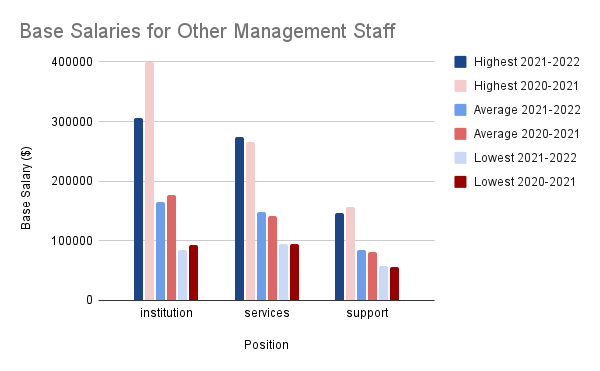
Not everyone satisfied with their salary last year
In the 2021–2022 academic year, many unions, including the McGill University Non-Academic Certified Association (MUNACA) and the Association of Graduate Students Employed at McGill (AGSEM), came into conflict with the administration over their members’ salaries. The Floor Fellows, represented by the Association of McGill University Support Employees (AMUSE), also went on strike demanding higher wages and retroactive pay from the administration. MUNACA president Thomas Chalmers told the Daily that McGill generally pays its employees less than other universities do.
“The recent past has shown that the university has an enormous difficulty to accept wage increase or monetary compensation asked by unions even though they are absolutely legitimate,” Mario Roy, president of AGSEM, told the Daily in an interview last year.
